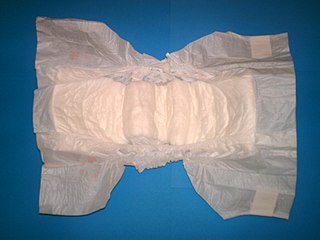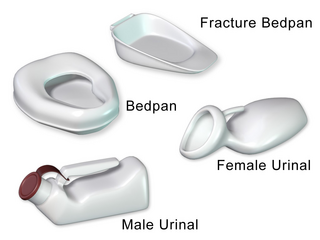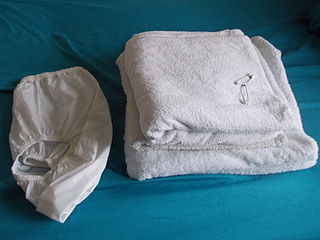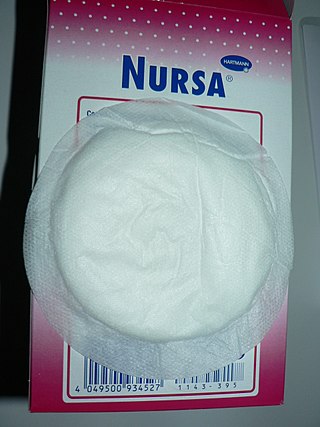Related Research Articles

A diaper or a nappy is a type of underwear that allows the wearer to urinate or defecate without using a toilet, by absorbing or containing waste products to prevent soiling of outer clothing or the external environment. When diapers become wet or soiled, they require changing, generally by a second person such as a parent or caregiver. Failure to change a diaper on a sufficiently regular basis can result in skin problems around the area covered by the diaper.

Urinary incontinence (UI), also known as involuntary urination, is any uncontrolled leakage of urine. It is a common and distressing problem, which may have a large impact on quality of life. It has been identified as an important issue in geriatric health care. The term enuresis is often used to refer to urinary incontinence primarily in children, such as nocturnal enuresis. UI is an example of a stigmatized medical condition, which creates barriers to successful management and makes the problem worse. People may be too embarrassed to seek medical help, and attempt to self-manage the symptom in secrecy from others.

A menstrual pad, or simply a pad, is an absorbent item worn by women in their underwear when menstruating, bleeding after giving birth, recovering from gynecologic surgery, experiencing a miscarriage or abortion, or in any other situation where it is necessary to absorb a flow of blood from the vagina. A menstrual pad is a type of menstrual hygiene product that is worn externally, unlike tampons and menstrual cups, which are worn inside the vagina. Pads are generally changed by being stripped off the pants and panties, taking out the old pad, sticking the new one on the inside of the panties and pulling them back on. Pads are recommended to be changed every 3–4 hours to avoid certain bacteria that can fester in blood; this time also may differ depending on the kind worn, flow, and the time it is worn.

Feminine hygiene products are personal care products used during menstruation, vaginal discharge, and other bodily functions related to the vulva and vagina. Products that are used during menstruation may also be called menstrual hygiene products, including menstrual pads, tampons, pantyliners, menstrual cups, menstrual sponges and period panties. Feminine hygiene products also include products meant to cleanse the vulva or vagina, such as douches, feminine wipes, and soap.

A slip is a woman's undergarment worn beneath a dress or skirt. A full slip hangs from the shoulders, usually by means of narrow straps, and extends from the breast to the fashionable skirt length. A half slip hangs from the waist. The word petticoat may also be used for half slips.

Goodnites are disposable underwear designed for managing bedwetting. Goodnites are produced by Kimberly-Clark. The product has also been seen titled as Huggies Goodnites on official Huggies branded webpages.
An incontinence pad is a small, impermeable multi-layered sheet with high absorbency that is used in the incontinence and health-care industries as a precaution against fecal or urinary incontinence. It is generally made of cotton if washable, or paper if disposable. Incontinence diapers are a common incontinence pad. Incontinence pads are usually placed in an undergarment or on a bed or chair under a person. Incontinence pads are manufactured in light and heavy grades which offer a range of absorbencies, often referred to as a 'working capacity', which refers to the true absorbency an incontinence pad offers when in use. These sorts of pads can come as panty-liners, inserts, pads or even available as replacement underwear.

A bedpan or bed pan is a device used as a receptacle for the urine and/or feces of a person who is confined to a bed and therefore not able to use a toilet or chamber pot.

Training pants are undergarments used by incontinent people, typically young children, as an aid for toilet training. They are intended to be worn in between the transition between wearing diapers but before they are ready to wear regular underpants. Training pants may be reusable and made of fabric, or they may be disposable. In the US, disposable training pants may also be referred to as "pull-ups", and in the UK, training pants are frequently referred to as nappy pants or trainer pants. The main benefit of training pants over diapers is that unlike traditional diapers, they can be easily pulled down in order to sit on a potty or toilet, and pulled back up for re-use after the person has used the toilet. The main benefit of wearing training pants over regular underpants is that if the person has an accident, they do not soil their environment.

A cloth diaper or a cloth nappy, also known as reusable diaper or reusable nappy, is a diaper made from textiles such as natural fibers, human-made materials, or a combination of both. Cloth diapers are in contrast to disposable diapers, made from synthetic fibers and plastics. They are often made from industrial cotton which may be bleached white or left the fiber’s natural color. Other natural fiber cloth materials include wool, bamboo, and unbleached hemp. Human-made materials such as an internal absorbent layer of microfiber toweling or an external waterproof layer of polyurethane laminate (PUL) may be used. Polyester fabrics microfleece or suedecloth are often used inside cloth diapers as a "stay-dry" wicking liner because of the non-absorbent properties of those synthetic fibers.

Stress incontinence, also known as stress urinary incontinence (SUI) or effort incontinence is a form of urinary incontinence. It is due to inadequate closure of the bladder outlet by the urethral sphincter.

Cloth menstrual pads are cloth pads worn in the underwear to collect menstrual fluid. They are a type of reusable menstrual hygiene product, and are an alternative to sanitary napkins or to menstrual cups. Because they can be reused, they are generally less expensive than disposable pads over time, and reduce the amount of waste produced.

TENA is a Swedish-based brand of Essity that specializes in products for adults with urinary or fecal incontinence, such as pads and diapers. TENA also produces a youth diaper brand for teenagers and larger children. The company has offices in all of North America, most of Europe, in Australia and New Zealand, and some parts of Asia and Central America. TENA has specific lines for retail and health care. They can be found at grocery, drug and discount stores, in aisles where other bladder control products are sold.
Omorashi, sometimes abbreviated as simply "omo", is a form of fetish subculture first categorized and predominately recognized in Japan, in which arousal from the idea or feeling of having a full bladder and potentially wetting themselves, or from witnessing another person in that situation.

An adult diaper is a diaper made to be worn by a person with a body larger than that of an infant or toddler. Diapers can be necessary for adults with various conditions, such as incontinence, mobility impairment, severe diarrhea or dementia. Adult diapers are made in various forms, including those resembling traditional child diapers, underpants, and pads resembling sanitary napkins. Superabsorbent polymer is primarily used to absorb bodily wastes and liquids.
gDiapers are a hybrid diaper, so users can choose to use either a cloth insert or a disposable insert that can be flushed or composted. Co-founders are Jason and Kimberley Graham-Nye. gDiapers began being sold in 2004. gDiapers are licensed from Kuver Designs Pty Ltd, Tasmania, "Eenee designs" diapers.

A swim diaper or swim nappy is a diaper that is made for those who have fecal incontinence, which is worn underneath a bathing suit, or as a bathing suit. Swim diapers can be reusable and disposable. They are not intended to be absorbent, but only to contain solid waste (feces); the lack of absorbency prevents the swim diaper from swelling with water.

A nursing pad is a cloth or disposable pad worn against the nipple and breast of a nursing mother to absorb any milk that may leak between feedings. It is inserted between the bra and the breast. Disposable pads are common and located easily online or in specialty stores. Reusable cloth pads can be washed and used over. These may be less expensive. Changing the pad when it is wet will keep the nipple clean and dry.
Depend is a brand of absorbent, disposable underwear and undergarments for people with urinary or fecal incontinence. It is a Kimberly-Clark brand, and positions its products as an alternative to typical adult diapers. Depend is the dominant brand of disposable incontinence garments in the United States with a 49.4 share of the market.

Period underwear are absorbent garments designed to be worn during menstruation. Period underwear is designed like conventional underwear but it is made up of highly absorbent fabrics to soak up menstrual blood. Most commercially manufactured period underwear makes use of microfiber polyester fabric. It is recommended that period underwear should be changed every 8-12 hours to avoid leakage and infection.
References
- ↑ Clarke-O’Neill, S., Pettersson, L. Fader, M. (2003) Washable products for women. Nursing Times, 99:(1), pp.57–58.
- ↑ "Facts and statistics for bladder problems". www.bladder-control.co.uk. Retrieved 2016-01-14.
- ↑ United Nations. (2013). World Population Ageing 2013. http://www.un.org/en/development/desa/population/publications/pdf/ageing/WorldPopulationAgeing2013.pdf
- ↑ "Yes, Incontinence Underwear Can Be Stylish!". Incontinence Blog - NationalIncontinence.com. Retrieved 2016-01-14.
- ↑ "Depend wants you to". ConsumerAffairs. Retrieved 2016-01-14.
- ↑ "AMV BBDO Tackles Incontinence for TENA Men". www.adweek.com. Retrieved 2016-01-14.
- ↑ "US incontinence market to reach a value of $1.6 billion in 2017". Yahoo Finance UK. Retrieved 2016-01-14.
- ↑ Johnsen, M. (December 15, 2014). Boomers, caregivers aid steady growth. Drug store news. pp. 62
- ↑ "New Zealand Startup Invents World's First 'Sexy' Incontinence Underwear". International Business Times AU. Retrieved 2016-01-14.
- ↑ "Incontinence lingerie on NZ catwalk as part of fashion week - BBC News". BBC News. Retrieved 2016-01-14.
- ↑ "Incontinence Lingerie Hits The Runway: A Brief Synopsis". InventorSpot.com. Retrieved 2016-01-14.
- ↑ "Urinary Incontinence Lingerie Collection Hits Runway". PSFK. 2015-09-04. Retrieved 2016-01-14.